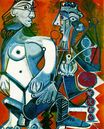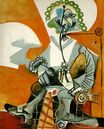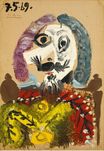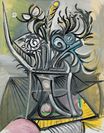©Pablo Picasso - Buste d’homme 1969
 |
 |
 |
 |
 |
 |
 |

Buste d’homme 1969
72x50cm oil/canvas
Sotheby's - Lot Estimate 900,000 — 1,200,000 GBP Private collection
The image is only being used for informational and educational purposes
<< Previous G a l l e r y Next >>
From Sotheby's auction house:
In early May 1969 Picasso painted several oils, including the present Buste d’homme, on the theme of the musketeer, which became one of the key subjects of his late œuvre. The image of the musketeer allowed Picasso to escape the limitations of contemporary subject matter and explore the spirit of a past age. These characters embodied the courtly mannerisms of the Renaissance gentleman and signified the golden age of painting, reflecting the influence of Velázquez, Rembrandt and Rubens on Picasso’s art. Picasso had devoted a large portion of his time and passion throughout the 1960s to the reinterpretation and investigation of the Old Masters, an experience in which he reaffirmed his connection to some of the greatest painters in the history of art. The musketeer series was a continuation of this interest and began, according to his wife Jacqueline Roque, ‘when Picasso started to study Rembrandt,’ but his appreciation of other great figures of the Renaissance, including Shakespeare, also influenced the appearance of these characters.
The musketeers are understood to be disguised portraits of Picasso himself, and their iconography is indicative of the artist’s self-awareness in his mature years. Towards the end of his life, the image of the musketeer evoked Picasso’s Spanish heritage and his nostalgia for the youthful vigour of his early years. As Marie-Laure Bernadac has observed: ‘If woman was depicted in all her aspects in Picasso’s art, man always appeared in disguise or in a specific role, the painter at work or the musketeer-matador holding the implements of his virility – the long pipe, the dagger, or the sword. In 1966, a new and final character emerged in Picasso’s iconography and dominated his last period to the point of becoming its emblem. This was the Golden Age gentleman, a half-Spanish, half-Dutch musketeer dressed in richly adorned clothing. […] all of these musketeers are men in disguise, romantic gentlemen, virile and arrogant soldiers, vainglorious and ridiculous despite their haughtiness’ (Brigitte Léal, Christine Piot & Marie-Laure Bernadac, The Ultimate Picasso, New York, 2000, p. 455).